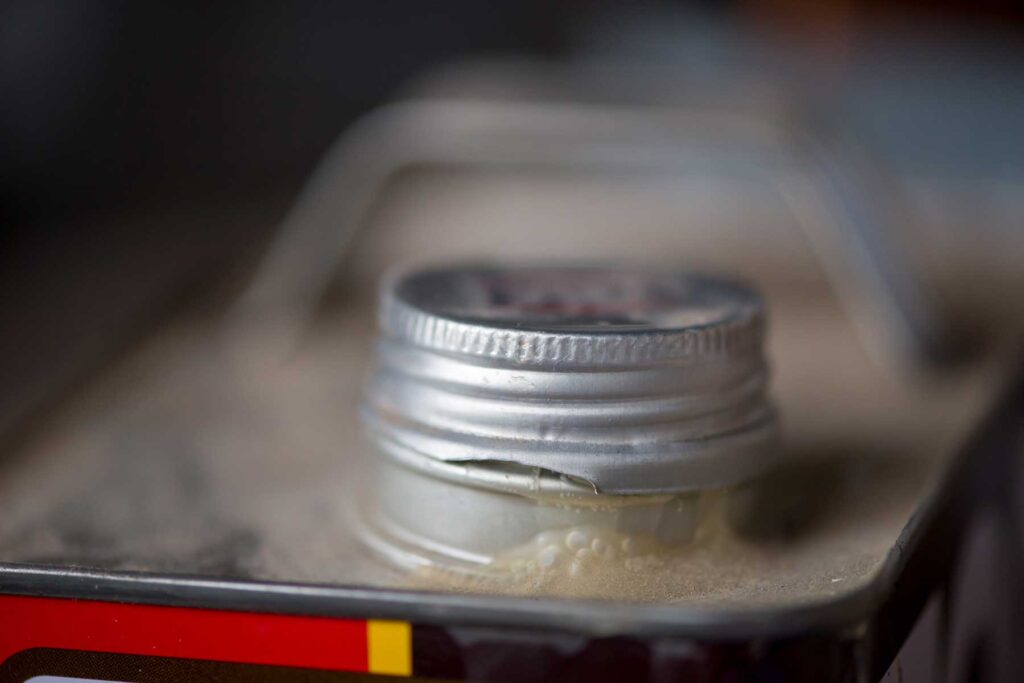
Exploring Modern Oil Paint Stability: Insights from Recent Scientific Studies
Artists and conservators continually seek a deeper understanding of the materials used in oil painting to enhance oil paint stability and the creation and preservation of artworks. The study “Metal Stearate Distributions in Modern Artists’ Oil Paints: Surface and Cross-Sectional Investigation of Reference Paint Films Using Conventional and Synchrotron Infrared Microspectroscopy” focuses on oil-based paints and provides valuable insights, particularly concerning the role of zinc oxide and aluminum stearate in modern oil paint formulations. This article delves into the experiment’s methodology, findings, and implications for artists and conservators.
The Experiment and Its Design
The study analyzed oil-based artists’ paint films, with particular attention to those containing zinc oxide. This pigment was either used as the primary component or alongside other common white pigments such as lead or titanium. Researchers employed both commercially available artists’ paints and bespoke control samples. These control samples were specifically created for the experiment, using defined combinations of pigments and oil, ensuring a clear comparison of results.
Key Findings on Paint Composition and Characteristics
Through detailed analysis, the study uncovered intricate details about the composition and characteristics of the paint films. Not only were the primary pigments identified, but the research also highlighted the presence of additional components such as extenders and stabilizers. This comprehensive profiling helps us understand how different ingredients interact within a paint film.
Impact of Aluminum Stearate on Zinc Carboxylates
One of the most significant findings was how the distribution of zinc carboxylates within the paint film is affected by the presence of other components, notably aluminum stearate. This additive was found to influence the formation and location of zinc carboxylates significantly. Zinc carboxylates are known to play a crucial role in the aging and stability of paint films, making this insight particularly valuable.
Long-Term Oil Paint Stability and Degradation
Further exploring the role of aluminum stearate, the study revealed its impact on the stability of paintings. The presence of aluminum stearate promotes a preferential concentration of zinc stearate at the lower margins of the paint film, closer to the protected underside. This finding suggests that aluminum stearate not only affects the physical distribution but also potentially the long-term stability of the paint by altering how degradation products aggregate within the film.
| Paint Manufacturer/Product Name/ Date of Film Casting | Composition | |
| Pigment | Oil | |
| Grumbacher Flake white 1978 | Basic lead carbonate, zinc oxide 20:1 | Linseed alkali refined + Al stearate |
| Grumbacher Titanium white 1978 | Titanium dioxide, zinc oxide 1:2; trace Al silicate | Linseed alkali refined + Al stearate |
| Grumbacher Zinc white 1978 | Zinc oxide; [Al, S, Cl] | Linseed alkali refined + Al stearate |
| Grumbacher Flake white 1999 | Basic lead carbonate, zinc oxide | Linseed alkali refined + Al stearate |
| Grumbacher Titanium white 1999 | Titanium dioxide, zinc oxide | Linseed alkali refined + Al stearate |
| Custom control Titanium white 1998 | Titanium dioxide (rutile), zinc oxide 12:1, Al silicate | Linseed grinding + Al stearate |
| Custom control Zinc white 1998 | Zinc oxide | Linseed grinding + Al stearate |
| Custom control Zinc white 1998 | Zinc oxide | Safflower alkali refined + Al stearate |
| Winsor Newton Titanium white 1978 | Titanium dioxide, barium sulfate; ZnO, CaCO3, [Al(OH)3] | Safflower |
| Colorlab Titanium white 1981 | Titanium dioxide, zinc oxide, barium sulfate 5:1:10 | Safflower + Al stearate |
| Colorlab Titanium white 1981 | Titanium dioxide, zinc oxide, barium sulfate 5:1:10; [Al, S, Cl] | Linseed + Al stearate |
Paints used in the study. The composition is specified by manufacturers, and additional details regarding pigments are determined using optical microscopy, FT-IR, and SEM-EDX. Paints with zinc oxide as the primary pigment (coded Z). Paints with zinc oxide as a minor pigment: lead-based (coded L); titanium-based (coded T), with relative proportions by weight where known.
Comparative Analysis Across Different Paints
By comparing the distribution of zinc stearate across various paint samples, researchers gained a clearer understanding of how different factors—such as the types of pigment used, the presence of aluminum stearate, and the choice of oil—affect the stability and degradation patterns of paint films. This comparative approach is crucial for predicting the longevity of artworks and strategizing their preservation.
Modern Oil Paint Stability
The results of this study are a step forward in the science of art materials, providing artists and conservators with critical data on how paint composition affects the aging and durability of oil paintings. Understanding these interactions helps make informed choices about materials and conservation practices, ensuring the longevity and stability of artworks for future generations to appreciate.
In conclusion, this research not only broadens our knowledge of paint material science but also reinforces the importance of meticulous material selection and the potential impacts of seemingly minor components on the overall integrity of oil paintings. As the art community continues to unravel the complexities of artistic materials, the fusion of science and art grows ever more crucial in preserving the cultural treasures of our past.
Understanding Key Concepts from the Study
One of the key concepts in the article focuses on carboxylates. What are carboxylates in the context of oil painting? Carboxylates are compounds formed when fatty acids in the oil react with metal ions, typically from pigments like zinc or lead. These reactions lead to the formation of metal carboxylates, which are categorized into polar and apolar (non-polar) phases based on their chemical properties:
- Polar Carboxylate Phases: These are portions of the carboxylate structures with a higher affinity for water due to their ability to form hydrogen bonds with water molecules. Polar carboxylates are generally more hydrophilic (water-attracting).
- Apolar Carboxylate Phases: Conversely, apolar carboxylates are hydrophobic (water-repelling) and do not mix well with water. These structures are typically non-polar, meaning they lack regions with significant positive or negative charges and do not interact strongly with polar solvents like water.
Significance of the Separation of Carboxylate Phases in Oil Paint
Impact on Long-term Stability and Mechanical Properties
- The separation of these phases can affect the overall stability of the paint film. Polar carboxylates might attract moisture, which can lead to issues like swelling, hydrolysis, or increased susceptibility to environmental degradation. Apolar carboxylates, being more resistant to moisture, might confer some protective properties to the paint but could also affect flexibility and adhesion negatively if not balanced correctly.
- This phase separation can lead to differential aging within the paint layer, where some areas degrade faster than others due to varying exposure to moisture and air. Over time, this uneven aging can cause cracking, flaking, or delamination of the paint film.
Implications for Conservation and Restoration
- Understanding how polar and apolar carboxylates distribute and behave in a painting helps conservators diagnose and address deterioration. For instance, areas rich in polar carboxylates might be more prone to water damage and could require different conservation strategies than more stable, apolar-rich areas.
- Knowledge of phase separation can inform the development of more effective preservation techniques, ensuring that artworks maintain their chemical and physical integrity.
Influence on Paint Formulation and Optimization
- For artists and paint manufacturers, recognizing how polar and apolar carboxylates behave can lead to better formulations of oil paints. Optimizing the ratio and distribution of these phases can enhance the handling properties, drying time, and eventual durability of the paint film.
- Paints can be engineered to minimize detrimental phase separations, reducing the risk of premature aging or mechanical failures like cracking.
For artists, understanding the implications of carboxylate phase separation extends beyond simple paint application. It encompasses the broader aspects of artwork longevity, preservation, and material science, highlighting the complex interplay between artistic materials and environmental factors. This knowledge empowers artists to make more informed choices regarding the materials they use and the techniques they apply, potentially influencing the lifespan and legacy of their artworks.
The key takeaway from this study is that the presence of aluminum stearate in paints containing zinc oxide leads to a preferential concentration of zinc stearate in the lower margins of the paint film, closer to the underside. This indicates that aluminum stearate influences the distribution and aggregation of zinc stearate within the paint film, potentially impacting the long-term stability of paintings.
Reference
Osmond G, Boon JJ, Puskar L, Drennan J. Metal stearate distributions in modern artists’ oil paints: surface and cross-sectional investigation of reference paint films using conventional and synchrotron infrared microspectroscopy. Appl Spectrosc. 2012 Oct;66(10):1136-44. doi: 10.1366/12-06659. PMID: 23031696. https://journals.sagepub.com/doi/10.1366/12-06659
Frequently Asked Questions (FAQs)
How do you stabilize oil paint?
Manufacturers often add stabilizers such as aluminum stearate to stabilize oil paint during storage. These additives help prevent pigment and oil separation. Properly storing oil paint in a cool, dry place away from direct sunlight helps maintain its stability. Using high-quality, artist-grade paints that contain appropriate ratios of pigments and binders is crucial for stability.
How can I tell if my oil paint contains zinc oxide?
Most artists’ paint manufacturers list the pigments in their paint on the tube label. If the paint contains zinc oxide, look for the Colour Index Generic Name (CIGN) Pigment White 4 or PW4. The pigment may also be identified by name, such as zinc white or zinc oxide.
How durable is oil paint?
Oil paint is renowned for its durability and rich color quality, making it a preferred medium for many artists. Its robustness is partly due to the oil binder, typically linseed oil, which forms a strong film as it dries. However, durability can be affected by various factors, including the quality of the pigments, the presence of additives, and the environmental conditions where the artwork is displayed or stored. Proper techniques and materials can greatly enhance the durability of oil paintings.
How long can oil paint sit out?
Oil paint can sit out for several days without drying if it is kept in an environment with controlled temperature and humidity. Covering the palette with a lid or plastic wrap can extend this time slightly by preventing excessive exposure to air. Some artists use a “wet palette,” which includes a sealable lid to keep the paint workable for longer periods. However, once mixed with mediums or solvents, the drying times can vary, and care should be taken to ensure the paint does not skin over or become contaminated.
Do oil paints ever go bad?
Oil paints can go bad, though this process can take many years if the paint is stored properly. Signs that oil paint has gone bad include a hard, unusable consistency. High-quality oil paints stored in aluminum tubes are less likely to go bad quickly as the sealed environment limits exposure to air and contaminants.
How can you tell if oil-based paint is bad?
To determine if oil-based paint has gone bad, check for signs such as:
- Separation: Separation of the oil from pigments in itself is not indicative of oil paint that has gone bad, but the oil can be reincorporated with the pigments before use.
- Texture: If the paint has hardened or dried in the tube, it may no longer be viable.
- Color: Any noticeable changes in color or consistency when applied could also indicate spoilage.







Responses